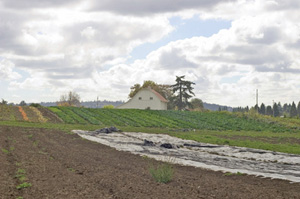
Features
Production
Research
Nematode control possible using soil solarization says U.S. researcher
March 15, 2008 By David Schmidt
With the number of available chemicals continually decreasing, growers are increasingly looking at non-chemical alternatives to
control pests.
 |
| Researchers in the U.S. are examining the use of transparent plastic sheeting as a way of heating up the soil and destroying soilborne pathogens, such as harmful nematodes. |
 |
| A close-up image of plastic sheeting. |
With the number of available chemicals continually decreasing, growers are increasingly looking at non-chemical alternatives to
control pests.
A new option to control root rot and nematodes may be soil solarization, says U.S. Department of Agriculture plant pathologist Jack Pinkerton of Oregon. Solarization attempts to destroy soilborne pathogens by heating the soil using solar radiation.
“Most soil pathogens are very susceptible at temperatures above 37ºC,” Pinkerton explains.
The process is actually quite simple. Transparent plastic sheeting is placed over tilled soil during the warmest and sunniest two months of the year. The plastic traps the sun’s heat, raising the temperature of the top few inches of the soil up to 11ºC higher than uncovered soil. He estimates the cost of installing and removing the plastic at $250 to $300 US per hectare.
The result seems to reduce “a number of” soil pathogens, including Verticillium wilt, crown gall, root-lesion nematodes and phytophora root rots, to a depth of almost one foot. It also decreases weed issues. At the same time, the number of more heat-tolerant “beneficial” microbes seems to increase.
“We’re modifying microbial communities, soil organisms and soil nutrients,” Pinkerton says, admitting researchers still don’t understand much of the process.
“It’s still a black box. We need more data on the effect of cumulative temperatures. We also want to know whether we can use it with reduced fumigants, whether we can combine it with green manure and whether we can plant through the plastic.”
But it works according to a research trial by Pinkerton and Washington State University researcher Pete Bristow. During July and August 2000, the pair tested solarized and unsolarized flat and raised beds, with or without a gypsum amendment, on a Vancouver, Wash., site infested with phytophora.
The plastic film was removed the following spring and raspberries planted in each plot.
“The solarized plots not only had more canes per hill, but the canes were heavier and longer,” Pinkerton states. “We saw a significant change in just the first year of production.”
In lab conditions, phytophora grows at 20ÞC to 27ºC but does not grow at 29ºC or above. It can be killed if a temperature of 29ºC can be maintained for 240 hours. A temperature of 35ºC will kill the organism if maintained for only 48 hours.
Pinkerton encourages growers to consider the treatment, even if it is not yet fully understood.
Print this page